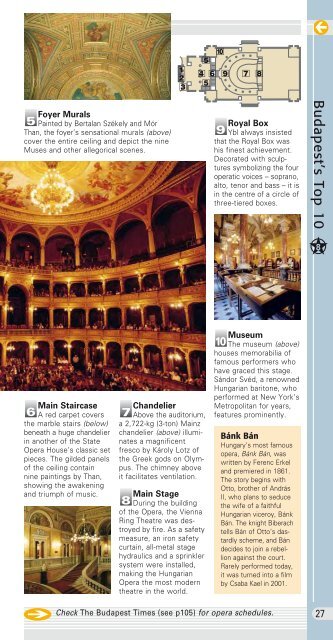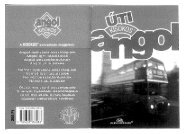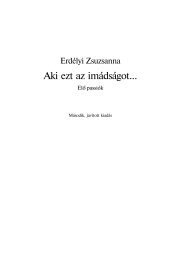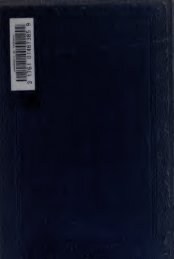You also want an ePaper? Increase the reach of your titles
YUMPU automatically turns print PDFs into web optimized ePapers that Google loves.
Foyer Murals<br />
Painted by Bertalan Székely and Mór<br />
Than, the foyer’s sensational murals (above)<br />
cover the entire ceiling and depict the nine<br />
Muses and other allegorical scenes.<br />
Main Staircase<br />
A red carpet covers<br />
the marble stairs (below)<br />
beneath a huge chandelier<br />
in another of the State<br />
Opera House’s classic set<br />
pieces. The gilded panels<br />
of the ceiling contain<br />
nine paintings by Than,<br />
showing the awakening<br />
and triumph of music.<br />
Chandelier<br />
Above the auditorium,<br />
a 2,722-kg (3-ton) Mainz<br />
chandelier (above) illuminates<br />
a magnificent<br />
fresco by Károly Lotz of<br />
the Greek gods on Olympus.<br />
The chimney above<br />
it facilitates ventilation.<br />
Main Stage<br />
During the building<br />
of the Opera, the Vienna<br />
Ring Theatre was destroyed<br />
by fire. As a safety<br />
measure, an iron safety<br />
curtain, all-metal stage<br />
hydraulics and a sprinkler<br />
system were installed,<br />
making the Hungarian<br />
Opera the most modern<br />
theatre in the world.<br />
1<br />
2<br />
3<br />
4<br />
0<br />
5<br />
6<br />
5<br />
9 7 8<br />
Royal Box<br />
Ybl always insisted<br />
that the Royal Box was<br />
his finest achievement.<br />
Decorated with sculptures<br />
symbolizing the four<br />
operatic voices – soprano,<br />
alto, tenor and bass – it is<br />
in the centre of a circle of<br />
three-tiered boxes.<br />
Museum<br />
The museum (above)<br />
houses memorabilia of<br />
famous performers who<br />
have graced this stage.<br />
Sándor Svéd, a renowned<br />
Hungarian baritone, who<br />
performed at New York’s<br />
Metropolitan for years,<br />
features prominently.<br />
Bánk Bán<br />
Hungary’s most famous<br />
opera, Bánk Bán, was<br />
written by Ferenc Erkel<br />
and premiered in 1861.<br />
The story begins with<br />
Otto, brother of András<br />
II, who plans to seduce<br />
the wife of a faithful<br />
Hungarian viceroy, Bánk<br />
Bán. The knight Biberach<br />
tells Bán of Otto’s dastardly<br />
scheme, and Bán<br />
decides to join a rebellion<br />
against the court.<br />
Rarely performed today,<br />
it was turned into a film<br />
by Csaba Kael in 2001.<br />
Check The Budapest Times (see p105) for opera schedules.<br />
Budapest’s Top 10<br />
27











